QuestionIt has been set up for 6 months.
55 gallon
Bala Shark, 4 mollies, 1 sunset platy, 1 frog, 1 loach and one blue guarami.
Power filter
Ph 6.2, ammonia off the charts (reads in the 8 ppm range), nitrite 0
Been doing every other day water changes of 20% and adding ammon lock.
Tank seems to be cycling again. Water is cloudy, and ammonia reads 8 even after the 20% change.
Yesterday, mollies seemed to have "bubbles" of air on their bodies.
Today, all are sick. Lost one overnight, others were quarantined, added ich clear to water in tank as they appear to have white spot on them. (hard to tell on the silver, but the black mollies I see whitepatches and the smaller female has swollen gills and they are red.
I have also been vacuuming the gravel 1 x week and changed the filter out last night, cleaned it out completely and then rinsed the filter cartridges and placed the same back in the tank.
Other tank is spiking ammonia as well. Current reading 2 ppm and less than 1 ppm nitrite. No fish seemed distressed so have not pulled any from the tank. Added ammon lock as directed - started 1 week ago. It is 20 gallon with 6 baby red velvet swordtail mollies and 1 dwarf guarami.
What do you think is happening>?
AnswerHi Maryann;
Poor guys. If the spots on the fish look like salt, it's ich. If they look more like patches, it's irritation from the ammonia or irritation has led to bacterial infection. The gills will redden from ammonia poisoning too. Don't put medicine in there right if they don't have salt specks like ich. The medicine irritates them too so the combination of medicine and ammonia can be deadly. Add two different things to help them for now until we can figure this out; Aquarium salt and MelaFix. They both soothe raw areas and the salt helps them get more oxygen as well as both inhibit further infection. Salt also weakens ich parasites if that's what they have.
There's something you might want to check before we go on to try fixing your tanks. Look at your test kit package or the bottle of solution and see what chemical is in it. If they are "salycilates" you are okay and the readings are indeed as high as they look. If you find that the chemical is a "nessler reagent". Your ammonia may not be as high as it looks. When ammonia binding chemicals such as AmmoLock are used they can cause sort of a "false-positive" ammonia reading. What often happens is we find an elevated ammonia level one day so we get some ammolock and put it in there. We test our tank water again with the nessler reagent ammonia kit and all of a sudden it's out of control! What we didn't know is that the nessler reagent is finding ammonia that has been made non-toxic by the ammolock. As far as the fish are concerned all or most of the ammonia is not really there. If you find that's what's going on, do another gravel vacuuming and 25% water change and get a different test kit that uses salycilates.
If your test kit is already a salycilate, let's move on;
For the 55 gallon; I very rarely recommend changing more than 25% of the water at once but I would change 50% of the water right away just this one time, vacuum at the same time and stop feeding the fish for 3 or 4 days. Without food going in there will be less ammonia continuing to be produced. Don't worry though, your fish will not starve. They can do quite well without food for up to 2 weeks. The pH is perfectly fine where it is because at a pH below 7.0 it makes the ammonia less toxic to the fish. Don't do anything with the filter. The beneficial bacteria needs to re-establish itself in there.
For the 20 gallon; Make a 25% water change and vacuum the gravel. Don't touch the filter. Feed very lightly.
Once the water changes are done and the fish should be feeling better, let's see what else we can do to stop this crazy ammonia train from careening down the tracks to further disaster;
The main cause of ammonia spikes is overfeeding. Feed your fish once a day and only give them enough to eat all of it from everywhere within 5 minutes. If there is any food left on the gravel, the plants, the decorations, etc, after five minutes it's too much food. Cut back next time and siphon out the excess. Even if the fish eventually eat it all over the next few minutes or hours, it's too much for the fish to digest properly and it just goes to waste, literally. The ammonia then rises. If you prefer feeding them twice a day you can do that just let them feed for about 2 1/2 minutes each time. The whole idea is to let them actively feed for 5 minutes every day. Babies are different and need food more often than adults. Not necessarily more food, just more often. Feed very tiny feedings several times a day. Get a couple of small cory cats to help pick up any leftovers if you need to. If you think your filters are sucking up a lot of food, turn them off for a few minutes as the fish feed. Just don't forget to turn them back on when they are done eating. Filters can suck up enough food that they get clogged so ammonia goes up from the decaying food.
Ironically enough, just as too much waste in the gravel and filter can cause excess ammonia, another cause is over cleaning of the gravel or the filter pads. The filter pads and gravel have beneficial bacteria growing in them that consumes the ammonia. If they are cleaned too vigorously it kills the bacteria. Try not to over clean the gravel when you vacuum. Just vacuum about half of the gravel bed one week, and the other half the following week. Rinse the filter pads in a container of tank water to get rid of the waste without killing off too much of the bacteria colonies. If you rinse the filter pads in tap water and the tap water has chlorine or other chemicals, the bacteria can die. Only put in new filter pads when they can't be rinsed enough to allow the free flow of water anymore or they are falling apart from age. I have some in my filters that are literally years old. My tanks are always crystal clear and the fish quite healthy. When I have to replace any old filter stuff for new, I leave in parts of the old to "spread" the bacteria from them to the new ones. Next time I clean them out, I remove the older material. The new ones will have grown enough bacteria to support the tank on their own.
Yet another cause of ammonia is the addition of new fish. It usually goes down in four or five days, but in the meantime the beneficial bacteria has to grow more colonies to compensate for the new "bio-load". Until they grow enough, the ammonia comes up. If too many new fish are added at once, the ammonia can become deadly. Only add one inch of fish for every ten gallons at a time. Add another inch per ten gallons in a week and keep doing that until the desired safe population is reached.
Let me know what you find out and we can go from there...
At Your Service;
Chris Robbins

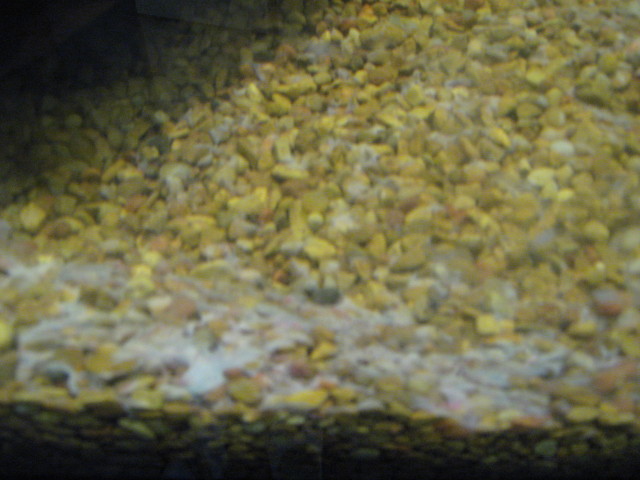 white cobwebs in my tank
Question
cobwebs
Hi!
Im a novice fish owner. weve had o
white cobwebs in my tank
Question
cobwebs
Hi!
Im a novice fish owner. weve had o
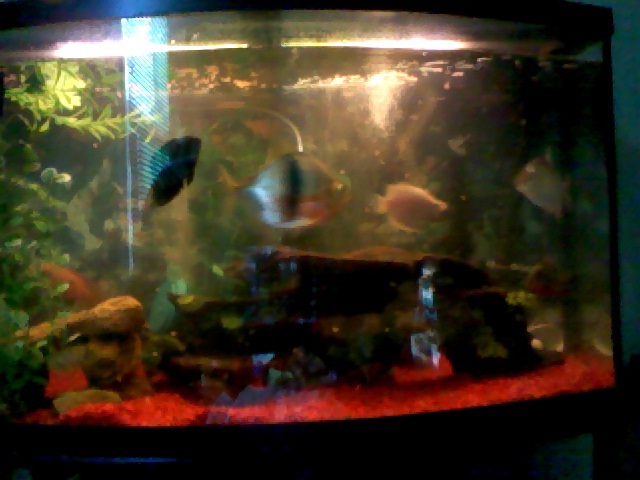 is my tank over stocked
Question
my tank
is my tank over stocked ...
1 jewel ci
is my tank over stocked
Question
my tank
is my tank over stocked ...
1 jewel ci
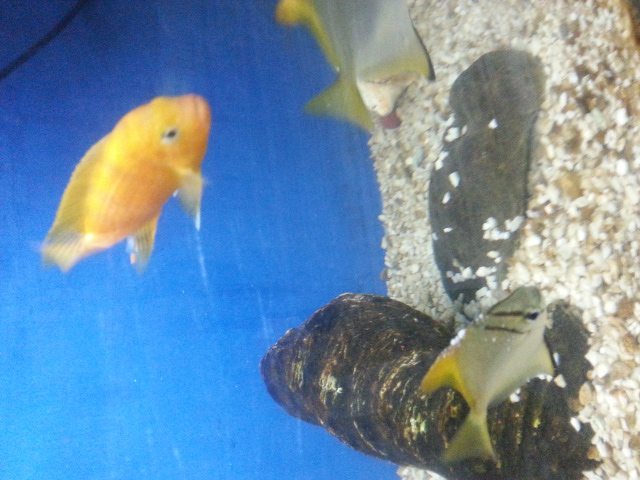 2 questions fr u!
Question
mono angel with some w
1)Recently I dis
2 questions fr u!
Question
mono angel with some w
1)Recently I dis
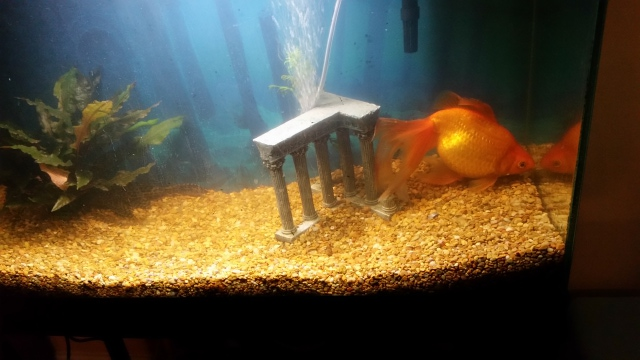 White spots and water issues
Question
Goldfish
I have 2 fish, 1 large fancy g
White spots and water issues
Question
Goldfish
I have 2 fish, 1 large fancy g
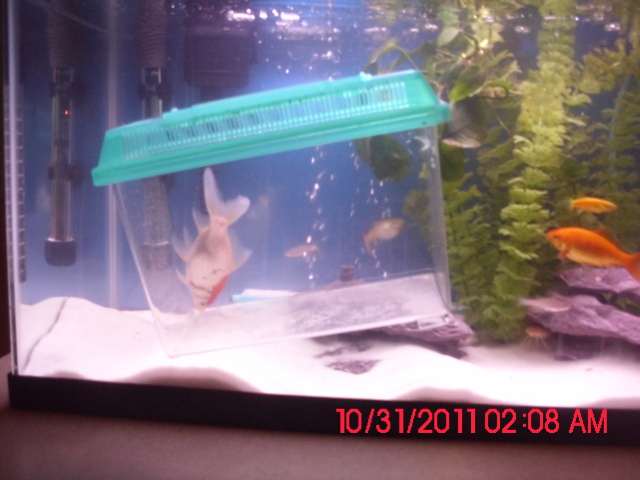 Facedown Gold fish
Question
face down gold fish
On firday i took my
Facedown Gold fish
Question
face down gold fish
On firday i took my